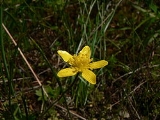
Ranunculus occidentalis
Encyclopedia
Ranunculus occidentalis (western buttercup) is a species of buttercup
found in the western United States
and Canada
. Its distribution extends from Alaska
through British Columbia
and Alberta
to central California
. The flower can be seen in open meadows, forests, and other generally flat areas up to an elevation of 2200 metres (7,217.8 ft).
Aleut Indians may have used juice from the plant as a poison
, its toxicity arising from the substance protoanemonin
. Shasta
Indians coincided blooming R. occidentalis with salmon run
s in the summer. The seeds were used to make pinole
, a staple food
.
This plant is similar to, and sometimes difficult to distinguish from, the California buttercup
(Ranunculus californicus).
Ranunculus
Ranunculus is a large genus of about 600 species of plants in the Ranunculaceae. Members of the genus include the buttercups, spearworts, water crowfoots and the lesser celandine....
found in the western United States
United States
The United States of America is a federal constitutional republic comprising fifty states and a federal district...
and Canada
Canada
Canada is a North American country consisting of ten provinces and three territories. Located in the northern part of the continent, it extends from the Atlantic Ocean in the east to the Pacific Ocean in the west, and northward into the Arctic Ocean...
. Its distribution extends from Alaska
Alaska
Alaska is the largest state in the United States by area. It is situated in the northwest extremity of the North American continent, with Canada to the east, the Arctic Ocean to the north, and the Pacific Ocean to the west and south, with Russia further west across the Bering Strait...
through British Columbia
British Columbia
British Columbia is the westernmost of Canada's provinces and is known for its natural beauty, as reflected in its Latin motto, Splendor sine occasu . Its name was chosen by Queen Victoria in 1858...
and Alberta
Alberta
Alberta is a province of Canada. It had an estimated population of 3.7 million in 2010 making it the most populous of Canada's three prairie provinces...
to central California
California
California is a state located on the West Coast of the United States. It is by far the most populous U.S. state, and the third-largest by land area...
. The flower can be seen in open meadows, forests, and other generally flat areas up to an elevation of 2200 metres (7,217.8 ft).
Aleut Indians may have used juice from the plant as a poison
Poison
In the context of biology, poisons are substances that can cause disturbances to organisms, usually by chemical reaction or other activity on the molecular scale, when a sufficient quantity is absorbed by an organism....
, its toxicity arising from the substance protoanemonin
Protoanemonin
Protoanemonin is a toxin found in all plants of the buttercup family . On maceration, for example when the plant is wounded, it is produced by an enzymatic process from the glucoside ranunculin...
. Shasta
Shasta (tribe)
The Shasta are an indigenous people of Northern California and Southern Oregon in the United States. They spoke one of the Shastan languages....
Indians coincided blooming R. occidentalis with salmon run
Salmon run
The salmon run is the time at which salmon swim back up the rivers in which they were born to spawn. All Pacific salmon die after spawning. While most Atlantic salmon die after their first spawn, about 5-10% return to the sea to feed between spawnings. The annual run is a major event for sport...
s in the summer. The seeds were used to make pinole
Pinole (staple)
Pinole is a Spanish translation of an Aztec word for a coarse flour made from ground toasted maize kernels, often in a mixture with a variety of herbs and ground seeds, which can be eaten by itself or be used as the base for a beverage...
, a staple food
Staple food
A staple food is one that is eaten regularly and in such quantities that it constitutes a dominant portion of a diet, and that supplies a high proportion of energy and nutrient needs. Most people live on a diet based on one or more staples...
.
This plant is similar to, and sometimes difficult to distinguish from, the California buttercup
California buttercup
Ranunculus californicus, the California buttercup, is a flowering plant of the buttercup family Ranunculaceae. It is a native of California, where it is common in many chaparral and woodlands and other habitats. Its distribution extends from Southern California north into Oregon and south into Baja...
(Ranunculus californicus).

